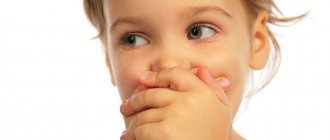adminUncategorized My child has a lisp - a frequent phrase running through the minds of parents. The main thing to understand here is that there is nothing wrong with this.
Lisp is a speech disorder, a type of sound pronunciation disorder. Manifests itself in the difficulty of reproducing whistling and hissing sounds. Often the defect disappears at the age of five years, after the development of the articulatory apparatus. But there is no guarantee of this. Therefore, when a child has a strong lisp, it is worth starting exercises to develop the speech organs.
The earlier the better!
It is believed that if a child has a lisp before the age of five, this should not be a cause for concern. It might even seem cute. Now imagine that this is a 16-year-old girl at school, an adult woman at work. Most likely, she will not be comfortable communicating with people and making acquaintances. The same goes for men. A lisp affects your future lifestyle and prevents you from achieving your goals. A person is simply embarrassed to speak, express opinions and ideas.
It is naive to expect that the defect will disappear on its own by 5-6 years. If this does not happen, too much falls on the child. After all, he is going to go to school. Then the children’s normal day is interrupted by visits to dentists, speech therapists, speech pathologists and countless home workouts. There are all the prerequisites for emotional exhaustion: stress, overload, demands from adults. The child may be afraid that his peers will laugh at him. The sooner treatment begins, the better.
We treat lisps from childhood
It is believed that if a child has a lisp before the age of five, it should not be a cause for concern. Plus, the little lisping baby looks so cute! Now imagine that this is a 16-year-old girl at school, an adult woman in the office. Most likely, she will not be comfortable communicating with people or making acquaintances. The same goes for men. A lisp affects your future lifestyle and interferes with achieving your goals. A person is simply embarrassed to speak, express ideas, opinions.
It is naive to expect that the defect will go away on its own before the age of 5-6 years. When this does not happen, too much falls on the child - after all, he is about to go to school. A child’s usual day is disrupted by trips to dentists, speech therapists, speech pathologists, and endless training at home. There are all the prerequisites for emotional burnout: stress, overwork, adult demands. Fears arise that speech will not improve, classmates will laugh, and accordingly, a fear of school is formed.
The sooner you start treating a child’s lisp, the better.
Exercises to prevent lisps in children
Relax the muscles of the tongue. You need to lick your upper lip, moving from top to bottom, then relax your tongue. Now say the “difficult” sounds. Perform the steps several times in this order. First, do this together with your child - you need to set an example.
"Naughty tongue." Children love this exercise very much. They do it unconsciously from childhood, just by playing. Therefore, make sure you do it correctly. Imagine that your tongue is a smooth spatula, which you need to place on your lower lip and speak like a bully “la-la-la.” In this case, the lip should not bend.
"Pancake." This is a massage exercise. Let the child imagine that the tongue is a pancake that needs to be spread on the lower teeth, sticking out a little forward. Now, lightly bite the tip with our front teeth. It was as if he wanted to tell a secret and changed his mind. After this exercise, the tongue should rest.
"Cup". It’s good if it follows the “pancake”, because it tastes better with tea. This way, your child will not forget the sequence of classes. You need to fix your jaw as if it were frozen. Now, without sticking out your tongue, you need to give it the shape of a cup, lifting the edges and the tip up. In this position, try to pronounce the letter "z". Don't be discouraged if you hear the letter "z" instead - this is normal.
Causes
Speech disorders do not arise out of nowhere. As a rule, changes in the functioning of the speech apparatus are preceded by certain events. Experts identify several factors that answer the question “Why does a person have a lisp?”:
- pathologies of the organs of the speech apparatus observed in a child from birth. An improperly developed frenulum, deviation in the length of the tongue, thick lips, etc. may be responsible for the development of pronunciation disorders of hissing and whistling sounds;
- developmental disorders of the maxillofacial apparatus, including malocclusion, high palate, diastema and other pathologies;
- neurological disorders that have a negative impact on the articulatory apparatus;
- if one of the family members suffers from this problem, the child lisps, imitating his manner of speech;
- physical damage to the facial part of the head;
- this disorder is often diagnosed in older people, due to hearing loss or missing teeth;
- hereditary predisposition.
This speech disorder is not a death sentence, which means there are ways to get rid of a lisp. The first step towards speech restoration is identifying the defect by its symptoms.
Exercises with words
"Cork". An ancient exercise that is practiced for various speech defects. You need to hold a wine cork or another, but safe, object in your teeth and start reading. Try to pronounce the words as clearly as possible. If the child does not read yet, then let him repeat rhymes after you and tell short fairy tales.
Patter. Choose tongue twisters that the child understands or that you can explain. Otherwise, the lesson turns into repetition of a series of words. But it becomes much more interesting with an understanding of the meaning. With this defect, tongue twisters are suitable for working with the sounds: ch, sh, shch, zh, s, z, ts.
In any case, the main thing is to take care of your child. And it partly manifests itself in monitoring health and possible disorders. If your child has specific speech problems, do not hesitate to contact a specialist.
There are no unsolvable problems, there are just lazy specialists. Professor Danilkina Margarita Yurievna has many scientific works on very complex diagnoses. Giving lectures at various universities around the world and conducting practical work. New techniques allow you to achieve amazing results.
Contact us at the center and you will see that together we can handle mountains.
What to do if your child has a lisp
However, do not rush to get excited: if such a “zest” is left to chance, it will result in big problems for the child. As he gets a little older, he may turn out to be a “black sheep” among his peers, and problems with his studies will inevitably arise. If you wish your baby a happier fate, read our guide to action.
A little about the concept
A lisp is understood as a speech defect, the main symptom of which is a violation of the pronunciation of whistling and hissing sounds. In other words, “zh”, “ch”, “sh”, “sch” in words are replaced by “z”, “ts”, “s”. The most common is the substitution of the sound “s” with “sh”: instead of “sister” the baby pronounces “sheshtra”, instead of “seven” - “shem”, etc.
The causes of such a speech disorder may be a short frenulum, weak tongue muscles, an incorrect bite, a gap between the front teeth, imitation of adults with a similar defect, long-term use of a pacifier, etc.
A lisp is common in many children. However, keep in mind: if before the age of 5 it is considered the norm, then after the five-year mark it is worth paying special attention to correcting such childish “spontaneity” in order to avoid difficulties with learning and communication. Therefore, it is only in your power to prevent possible future troubles in your child’s life.
Recommendations for parents:
1. Make sure that nothing is preventing the child from breathing properly.
Certain problems that make it difficult to breathe through the nose contribute to the development of a lisp. This is due to the fact that the child begins to breathe through the mouth, and the tongue flattens and protrudes outward. Even if everything is fine outwardly, it is worth showing the child to an otolaryngologist. An examination by a doctor will reveal possible problems with the sinuses, allergies, etc.
2. Away with bottles and pacifiers!
Although such devices make life easier for parents, they are, alas, very harmful for children. The fact is that all kinds of nipples inhibit the development of oral motor skills, which take part in the development of speech. Therefore, dear mothers and fathers, wean your baby off pacifiers as early as possible, and as an alternative, teach him to use a straw. On the contrary, it helps to train the necessary speech motor skills.
3. Remove your finger from your mouth.
Another possible cause of a lisp is thumb sucking. Therefore, watch your baby: does he suffer from the habit of keeping his thumb in his mouth? If so, when is he most likely to do this? When a “dangerous” moment occurs, your task will be to switch your attention to another activity or object, say, your favorite toy. It is quite problematic to quickly rid a child of this bad habit, but reducing the time spent on it is a completely feasible task.
4. Don't put pressure on your child!
React calmly and do not swear if, in response to your exhortations and explanations, the baby again lisps, makes mistakes, or sucks his thumb. Seeing your negative attitude, the baby will be upset: he understands that he is doing something bad. Forget about the habit of constantly correcting your child and forcing him to pronounce words correctly. It’s a paradox, but by doing this, you only contribute to strengthening the mistakes in the little man’s speech.
5. Make an appointment with a speech therapist.
You are mistaken if you think that a lisp will go away on its own by a certain age. This, of course, happens, but not always. Therefore, show your child to a speech therapist who can correct such a problem with effective training. The sooner you do this, the better: speech defects have the ability to become fixed.
6. We work with the child on our own.
There are times when visiting a speech therapist is not possible at the moment. But here there is a solution: do not waste precious time and start doing some effective exercises with your baby, preferably several times a day. Thanks to them, you can correct your child’s lisp, and in uncomplicated cases, forget about it forever.
Some home exercises to do with your child:
• click your tongue like a horse;
• talk with your mouth closed: the exercise is difficult, but it improves diction very well;
• cup your tongue and pronounce the alphabet one letter at a time. The exercise is done with the mouth open;
• open your mouth as wide as possible and throw your tongue out of your mouth with sharp movements. You can tell the baby that in this way we catch mosquitoes with our tongue.
Ridding a baby of a lisp is a feasible task. And so that it can be resolved with minimal effort, take measures that are in your hands. If you have such a speech defect, be attentive to your child, show him to specialists in time, have patience, calmness and love to carry out the necessary recommendations and exercises. Then a positive result in the form of your baby’s correct speech will not be long in coming.
Correction
Restoring the correct functioning of the speech apparatus requires quite a long time and does not give immediate results, although in the case of surgical intervention some improvements are possible within a week after the operation.
The correction is based on an integrated approach to how to stop a lisp, and includes not only speech therapy measures, but also the work of a teacher, psychologist, dentist and other specialists as necessary in each individual case.
In the problem of how to learn to live without a lisp, correction of sound pronunciation and proper breathing, exercises to develop the articulatory apparatus, tongue massage and other procedures will help. In especially severe cases, an adult patient may require dental prosthetics, bite correction, or surgery to correct the muscles of the tongue.
Correction is much easier if the child has a lisp before the age of 7. Correction of sound pronunciation at this age is carried out naturally, subject to certain rules and exercises to prevent the development of pathology. It is more difficult for a teenager, like older patients, to deal with a lisp, but you can get rid of it by strictly adhering to the plan drawn up by a specialist.
Exercises to correct the pronunciation of sounds
Several basic exercises created by speech therapists will tell you how to learn how to correct sound pronunciation yourself. If you do these exercises regularly, the results will not be long in coming.
- Relaxation. Licking the upper lip from top to bottom will help relax the muscles of the tongue. After completing this exercise, you can move on to pronouncing sounds with which you have difficulty.
- Cup. To complete this task, you need to fix your jaw in one position. Make a kind of cup with your tongue, equally lifting its side and front walls. Next, you need to try to pronounce the sound [z], which in this exercise will be more similar to [z].
- Cork. Reading aloud with a bottle cap clamped in your teeth has a good effect on the development of the speech apparatus. There are usually no difficulties in learning to read with a foreign object in your teeth.
- Reading through lips. Doctors recommend regularly reading small pieces of text with your mouth closed. It is necessary to compress your lips tightly, slightly opening your teeth, and begin to read the text so that it can be heard.
- Tongue Twisters. One of the best ways to correct a lisp is to memorize and pronounce tongue twisters. In order not to develop a problem in the form of a lisp, it is necessary to pronounce tongue twisters as a preventive measure.
The above describes only the basic exercises for correcting a lisp. In fact, there are many more of them. In addition to completing tasks to develop the speech apparatus, it is also necessary to devote time to breathing, which often becomes confused during excitement and causes incorrect pronunciation of sounds, thereby creating problems not only for people with a lisp.
Parents of a small child should take note of how to learn to speak correctly with him as he develops. As a preventative measure, it is necessary to do various play exercises with the baby to establish the correct sound pronunciation, and also teach the child tongue twisters.
People have a lisp for a variety of reasons. Some people even like this feature, but experts remind that a lisp is a problem that needs to be addressed, even though it does not cause any significant harm to health.
Symptoms
The main symptoms of a lisp include the following:
- incorrect positioning of the tongue when pronouncing sounds;
- difficult and incorrect pronunciation of whistling and hissing sounds;
- patients try to avoid pronouncing difficult words;
- children can confuse syllables, replacing complex syllables with easier ones to pronounce;
- Many people with a lisp withdraw into themselves and try to minimize live communication, preferring text communication.
Identifying the disorder among children whose speech is just beginning to develop can be difficult. Adult patients, in turn, are strongly recommended not to be embarrassed by a lisp, but to immediately consult a specialist.
Diagnostics
At the first manifestation of symptoms of a lisp, you should contact a speech therapist, who will assess the degree of development of the pathology and show you how to learn to perform the exercises that form the basis of the correction course. During the inspection, the specialist records the following points:
- the way the patient pronounces sounds;
- features of the functioning of auditory and visual channels of information perception;
- work of the articulatory apparatus;
- psychospeech development of the patient;
- writing and reading skills;
- memory quality;
- literacy in speech construction.
Depending on the reasons that provoked the occurrence of deviations, the patient may be referred to an appointment with a dentist, surgeon or otolaryngologist.
Why does he lisp?
Ideally, by the age of six, a child should be able to correctly pronounce all the sounds of his native language. If there are difficulties with several sounds, then speech therapists talk about an age-related time delay in sound pronunciation.
The most common causes of this phenomenon are weakness of the muscles of the tongue or lips, impaired articulation or improper speech breathing, as well as slight uncoordination of movements. You can cope with this with the help of special speech therapy exercises, as well as developing fine motor skills.
For example, there are special gymnastics for training the tongue and lips; exercises will allow these organs to be more mobile and take the necessary position. After this, correct articulation is honed with the child in front of a mirror, correlating the pronunciation of a particular sound with a certain position of the tongue and lips.
One more point: in Russian speech, words are pronounced as you exhale. Only in this case will you be able to pronounce them correctly.
But it is also very important in what speech environment your child lives. Sometimes problems arise because the child copies the pronunciation of his friends who have not yet pronounced certain sounds. Or the family talks to him, lisping, deliberately distorting words, imitating baby babble.
So, before you start classes with a speech therapist, take care of proper speech in your family. Explain to your child that there is no need to copy your friend with a lisp; it is better to learn to speak correctly together.
5 facts about speech development. Truth and myths
More details
Shall we try?
Here are a few exercises to strengthen the muscles of the mouth, which are usually prescribed to all children:
Cup. Curl your tongue into a cup shape.
Carnations. With the tip of your tongue, tap sequentially on the gums of each tooth - with jerky short movements.
Swing. Open your mouth and stretch your lips into a smile. The tip of the tongue should be raised to the upper incisors, then rhythmically lowered to the lower ones. At the same time, make sure that the chin does not move - only the tongue.
Cat. You make movements with your tongue, as if you were lapping milk from a saucer.










